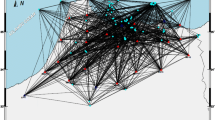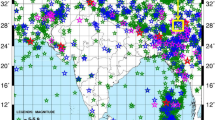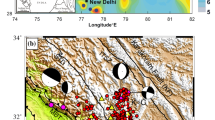Abstract
CodaQ (Q c) estimates for the Kumaun Himalaya region have been obtained in high frequency range. Local earthquakes, recorded by a digital seismic network in the region, which fall in the epicentral distances range of 10 to 80 km and with a local magnitude range of 1.4 to 2.8, have been used. The coda waves of 30 sec window length, filtered at seven frequency bands centered at 1.5, 3, 6, 9, 12, 18 and 24Hz, have been analysed using the single backscattering model. The values ofQ c estimates vary from 65 to 283 at 1.5 Hz to 2119 to 3279 at 24.0 Hz which showed thatQ c is frequency dependent and its value increases as frequency increases.
A frequency-dependentQ c relationship,Q c = (92 ± 4.73)f(1.07±.023), is obtained for the region representing the average attenuation characteristics of seismic waves for Kumaun Himalaya region.
Similar content being viewed by others
References
Aki K 1980 Scattering and attenuation of shear waves in the lithosphere;J. Geophys. Res. 85 6496–6504
Aki K and Chouet B 1975 Origin of the coda waves: source attenuation and scattering effects;J. Geophys. Res. 80 3322–3342
Gupta S C, Singh V N and Kumar A 1995 Attenuation of coda waves in the Garhwal Himalaya, India;Phys. Earth and Planet. Interiors 87 247–253
Gupta S C 1999 Seismic wave attenuation characteristics of three Indian regions; Ph.D. Thesis. University of Roorkee, Roorkee, pp. 200 (unpublished)
Malinconico Jr L L 1989 Crustal thickness estimates of the western Himalaya. In:Tectonics of the western Himalayas (eds) L L Malinconico Jr. and R J Lillie;Geol. Soc. Am. Spl. Paper 232 237–242
Molnar P and Tapponnier P 1975 Cenozoic tectonics of Asia: Effects of a continental collision;Science 189 419–426
Powell C Mc A 1979 A speculative tectonic history of Pakistan and surroundings: Some constraints from Indian Ocean. In:Geodynamics of Pakistan, (eds) A Farah and K A DeJong, Geological Survey of Pakistan 5–24
Pulli J J 1984 Attenuation of coda waves in New England;Bull. Seismol. Soc. Am. 74 1149–1166
Rautian T G and Khalturin V I 1978 The use of the coda for the determination of the earthquake source spectrum;Bull. Seismol. Soc. Am. 68 923–948
Roecker S W, Tucker B, King J and Hatzfield D 1982 Estimates ofQ in central Asia as a function of frequency and depth using the coda of locally recorded earthquakes;Bull. Seismol. Soc. Am. 72 129–149
Valdiya K S 1995 Proterozoic sedimentation and Pan African geodynamic development in Himalaya;Precambrian Research 74 35–55
Valdiya K S 1999 Fast uplift and geomorphic development of the western Himalaya in Quaternary period. In:Geodynamics of NW Himalaya Gondwana Research Group Memoir (eds) A K Jain and Manickvasagam6 179–187
Woodgold CRD 1994 Coda Q in the Charlevoix, Quebec, region: Lapse-time dependence and spatial and temporal comparison;Bull. Seismol. Soc. Am. 84 1123–1131
Author information
Authors and Affiliations
Rights and permissions
About this article
Cite this article
Paul, A., Gupta, S.C. & Pant, C.C. CODA Q estimates for Kumaun Himalaya. J Earth Syst Sci 112, 569–576 (2003). https://doi.org/10.1007/BF02709780
Received:
Revised:
Issue Date:
DOI: https://doi.org/10.1007/BF02709780




